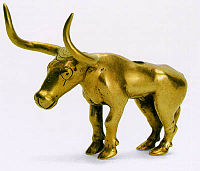- Maykop culture
-
Bronze Age
↑ Chalcolithic Near East (3300-1200 BC)
- Caucasus, Anatolia, Levant, Egypt, Mesopotamia, Elam, Jiroft
- Bronze Age collapse
Europe (3200-600 BC)
- Aegean (Minoan)
- Caucasus
- Catacomb culture
- Srubna culture
- Beaker culture
- Unetice culture
- Tumulus culture
- Urnfield culture
- Hallstatt culture
- Atlantic Bronze Age
- Bronze Age Britain
- Nordic Bronze Age
- Italian Bronze Age
Indian Subcontinent (3300-1200 BC)
China (3000-700 BC)
Korea (1500-300 BC)
arsenical bronze
writing, literature
sword, chariot↓ Iron Age  Golden ox figurina. Middle of 3rd millennium BC. Found in Maykop kurgan. Hermitage Museum exhibition.
Golden ox figurina. Middle of 3rd millennium BC. Found in Maykop kurgan. Hermitage Museum exhibition.
The Maykop culture (also spelled Maikop), ca. 3700 BC—2500 BC, was a major Bronze Age archaeological culture situated in Southern Russia running from the Taman Peninsula at the Kerch Strait nearly to the modern border of Dagestan, centered approximately on the modern Republic of Adygea (whose capital is Maykop) in the Kuban River valley. The culture takes its name from a royal burial found there. The Maikop Barrow was first discovered in 1897.
Its inhumation practices were typically Indo-European, typically in a pit, sometimes stone-lined, topped with a kurgan or (tumulus). The Maikop Barrow, was extremely rich in gold and silver artifacts; unusual for the time. The Mayop culture is also believed to be one of the first to take of the wheel.
Contents
Territory
The Kuban River is navigable for much of its length, and an easy water-passage via the Sea of Azov into the territory of the Yamna culture, by way of the Don and Donets River systems was available. The Maykop culture was well-situated to exploit the trading possibilities of the central Ukraine area.
In 2010, nearly 200 Bronze Age sites were reported stretching over 60 miles between the Kuban river and Nalchik between 4,620 feet and 7,920 feet. They were all "visibly constructed according to the same architectural plan, with an oval courtyard in the center, and connected by roads."[1]
Contemporaneous cultures
It is approximately contemporaneous with and is apparently influenced by the Kuro-Araxes culture (3500—2200 BC) which straddles the Caucasus and extends into eastern Anatolia. To the north and west is the similarly contemporaneous Yamna culture and immediately north is the Novotitorovka culture (3300—2700), which it overlaps in territorial extent.
Culture
The culture takes its name from a royal burial found there. The Maikop Barrow, was extremely rich in gold and silver artifacts; Exceptional for the time.
The Maykop culture is believed to be one of the first to take of the wheel.
Its inhumation practices were typically Indo-European, typically in a pit, sometimes stone-lined, topped with a kurgan or (tumulus). Stone cairns replace kurgans in later interments. Because of its burial practices, and in terms of the Kurgan hypothesis of Marija Gimbutas, it is listed as an intrusion from the Pontic steppe into the Caucasus. According to Mallory this is hard to evaluate and he emphasizes that: where the evidence for barrows is found, it is precisely in regions which later demonstrate the presence of non-Indo-European populations.[2] In other occasions the culture has been cited, at the very least, as a kurganized culture with a strong ethnic and linguistic links to the descendants of the Proto-Indo-Europeans. It has been linked to the Lower Mikhaylovka group and Kemi Oba culture, and more distantly, to the Globular Amphora and Corded Ware cultures, if only in an economic sense. Mallory states:
Such a theory, it must be emphasized, is highly speculative and controversial although there is a recognition that this culture may be a product of at least two traditions: the local steppe tradition embraced in the Novosvobodna culture and foreign elements from south of the Caucasus which can be charted through imports in both regions.—EIEC,"Maykop Culture".
Anatolian theory
Gamkrelidze and Ivanov, whose views are somewhat controversial, suggest that the Maykop culture (or its ancestor) may have been a way-station for Indo-Europeans migrating from the South Caucasus and/or eastern Anatolia to a secondary Urheimat on the steppe. This would essentially place the Anatolian stock in Anatolia from the beginning, and at least in this instance, agrees with Colin Renfrew's Anatolian hypothesis. Considering that some attempt has been made to unite Indo-European with the Northwest Caucasian languages, an earlier Caucasian pre-Urheimat is not out of the question (see Proto-Pontic). However, most linguists and archaeologists consider this hypothesis highly unlikely, and prefer the Eurasian steppes as the genuine IE Urheimat.
See also
- Maykop kurgan
- Rudna Glava
- Bronze
Source
- J. P. Mallory, "Maykop Culture", Encyclopedia of Indo-European Culture, Fitzroy Dearborn, 1997.
Footnotes
- ^ "Bronze Age Civilization Spotted in Old Photographs". Associated Free Press (Discovery.com). October 12, 2010. http://news.discovery.com/archaeology/ancient-civilization-caucasus.html. Retrieved October 14, 2010.
- ^ In Search of the Indo-Europeans - J.P.Mallory, Thames and Hudson, 1987, ISBN 0-500-27616-1, p233
Categories:- Archaeological cultures
- Indo-European
- Bronze Age Europe
- Encyclopedia of Indo-European Culture
- Archaeology of Russia
- Archaeology of Kuban
- Archaeology of the Caucasus
- 4th millennium BC
Wikimedia Foundation. 2010.
